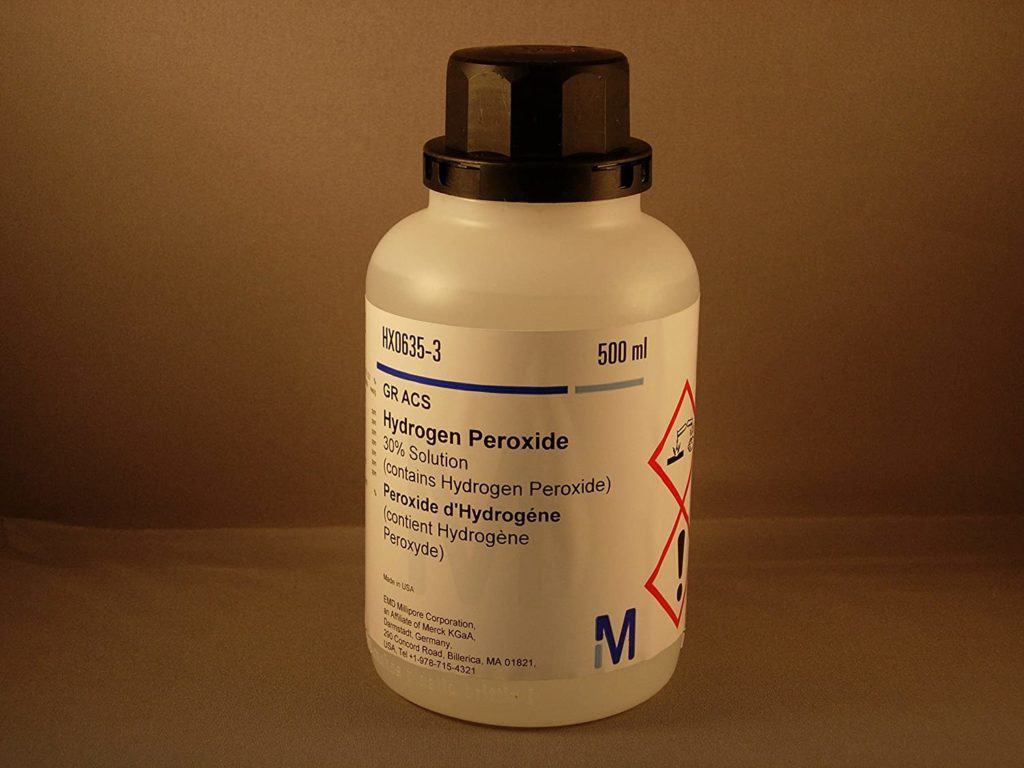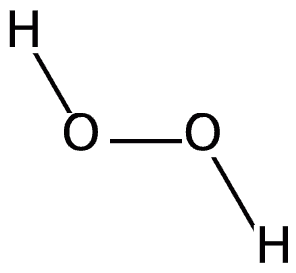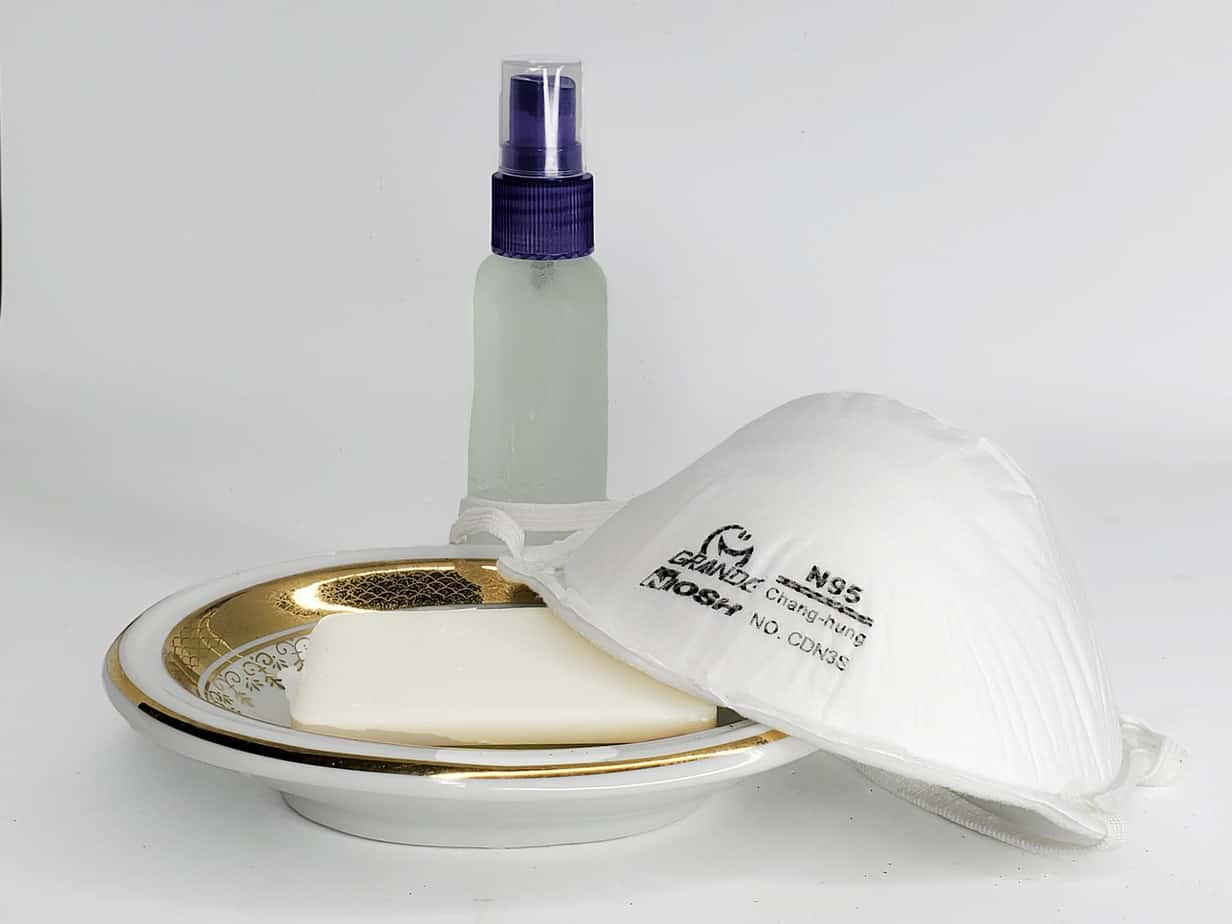Hydrogen peroxide is a reliable disinfectant that has the highest effect for up to thirty minutes, when applied in temperatures of about twenty degrees Celsius, according to the CDC. Overall, it can keep the treated surface-sterilized for over six hours, and it is advisable to reuse the product after twenty-one days.
The product is effective against a wide range of microorganisms, and it works through the production of destructive hydroxyl free radicals. The radicals attack the essential cell components, although the rate of disinfection highly depends on the product’s concentration.
This chemical compound has a shelf life of two years, with zero disposal restrictions, and can be used on many materials. However, proper storage measures are required to ensure the product remains stable for long. That’s why experts recommend storing hydrogen peroxide safely in dark containers to prevent decomposition. Also, it is required to wear eye protection gear when using the product, as it is a serious irritant.
Are you wondering how the hydrogen peroxide disinfection process works? When and how to use it? Let me help you to learn more about this disinfector.
When to Use Hydrogen Peroxide

The product has been in use for ages, although initial applications included treatment of cuts. However, researches now show that hydrogen peroxide kills healthy cells as well, and it is an eye and skin irritant. The findings have reduced its usage in hospitals, although the product still finds application in several settings, including:
- Removing pit stains – Use dishwashing detergent and then apply hydrogen peroxide on the stains about an hour later. Ensure you wash the cloth with cold water.
- Washing the dishes – Spray a considerable amount of hydrogen peroxide and wipe the utensils after a few minutes. Dry the dishes overnight before using them.
- Cleaning your laundry – The disinfectant removes stains on clothes, and all you need is to add a cup of hydrogen peroxide into your washing machine. It is important to conduct a color check when cleaning darker garments.
- Sanitizing any surface – When used with other cleaners, hydrogen peroxide sanitizer works ideally in ensuring germs, bacteria, and viruses levels are within approved standards. Use the manufacturer’s recommended concentration and quantity for optimal results.
The Disinfectant Power of Hydrogen Peroxide
Many people are wondering if the product is effective against germs and bacteria. The section below has answers to these queries that should help you to understand whether you need to use this solution or not.
Does Hydrogen Peroxide Kill Germs?
The product is extremely helpful in eliminating germs, as it destroys germ cells. It works on multiple microorganisms, meaning that a single product can be used to disinfect the whole household.
However, hydrogen peroxide works best in a 3% concentration, as per the CDC. It can deactivate common respiratory viruses in about eight minutes. Besides that, it destroys germs on surfaces, and the effect remains active for long.
But besides killing germs, does hydrogen peroxide sanitize? Sanitizing doesn’t imply eliminating the germs but ensuring their number is manageable so that they can hardly cause an illness. This chemical compound works the same way and can be used as a sanitizer at home.
How can one disinfect or sanitize with hydrogen peroxide to eliminate germs? This chemical compound is conveyed in a 3% concentration, but you can mix it with water to about 0.5%.
After cleaning the surface, spray considerable amounts of the product on it and wait for a few minutes before wiping out the solution. This waiting time is enough to kill bacteria on the surface.
Also, ensure you use protective wear during the process. It is important since the product is highly irritating when in contact with the skin. The best protective measure to take is to use gloves.
How Does Hydrogen Peroxide Kill Viruses?
The effectiveness of this product in killing viruses is almost similar to that of germs. An important thing about the item is that it kills multiple microorganisms, and it makes hydrogen peroxide as a disinfectant highly versatile.
That said, the product kills viruses on hard and non-porous services. It can be used in the purchased 3% concentration, or you can dilute it to about 0.5% concentrations, as it remains effective.
When you use it in the initial high concentration, wear gloves and other protective gear, as it is highly irritating to the skin and eyes. That said, the product’s chemical properties mean it can’t be applied on all surfaces, and below is a list of things you shouldn’t use the solution on:
- Copper
- Rubber
- Aluminum
- Brass
- Steel
- Wood
- Zinc
This chemical compound is also known to cause mild discoloration. It is, therefore, important to test on the surface before applying the solution all over the place. All in all, it is an ideal option compared to bleach.
During the application process, ensure hydrogen peroxide stays on the surface for about five minutes to allow it to kill viruses effectively. When storing the product, completely shield the bottle from light, as the chemical compound can easily decompose to water.
Does Hydrogen Peroxide Kill Bacteria?
As earlier noted, the product excites due to its ability to kill a wide variety of microorganisms. Bacteria are no exception here, and this chemical compound can kill them in minutes. Spray the solution on frequently used surfaces or objects, including doorknobs, switches, sinks, and handles to eliminate bacteria.
In the process of application, make sure you keep your hands and eyes protected, as hydrogen peroxide is a known irritant. Also, ensure you correctly follow the laid instructions depending on where you are using the product.
All in all, one good advantage of hydrogen peroxide is the way it easily decomposes to water after a while that means that wiping it out or rinsing isn’t necessary. There are also no restrictions on how to dispose of the product after use.
Hydrogen peroxide is a great alternative to bleach, as it has minimal discoloring effect, and it is eco-friendly. Additionally, it doesn’t produce harmful gasses.
Cleaning Using Vinegar and Hydrogen Peroxide

Vinegar is easily accessible and cheap, and that makes it a viable householder cleaning option. It is also effective in removing stains. For cleaning purposes, make sure you use white vinegar, as opposed to wine or cider vinegar.
However, bear in mind that vinegar isn’t a good disinfectant, as it won’t kill all the germs. It is ineffective against microorganisms and requires using in high concentrations. That’s why many people don’t apply it for sanitizing purposes, but it can’t be beneficial in combination with real-working disinfectors.
As seen on the National Sanitation Foundation, if you decide to use white vinegar with hydrogen peroxide or bleach, do not mix the two, as they will end up producing toxic fumes. Use vinegar that contains 5% acetic acid and 3% hydrogen peroxide for ideal cleaning.
First, clean the surface with soap and water before applying any sanitizer or disinfectant. Then spray diluted vinegar in a 1:1 ratio with water on the area and wait for about thirty minutes before wiping it out. This period allows the product to work and kill germs optimally.
Use clean pieces of cloth to wipe the solution and rinse the surface with warm water. After that, spray this chemical compound on the clean area and wipe after five minutes. With items, you don’t have to rinse them afterward, as hydrogen peroxide decomposes to water after some time.
Finally, bear in mind that vinegar has a distinctive smell that only disperses after complete evaporation. It is an important consideration, especially if you are using the product around people sensitive to strong scents.
Two Helpful Hydrogen Peroxide Cleaning Products
Using a 3% concentrated hydrogen peroxide provides excellent disinfecting and sanitizing results. The product is more effective than bleaches, and it is also a safer option. That said, you can find some ready-made hydrogen peroxide products that are ideally mixed to make them highly effective and available to use right away.
The products kill bacteria and viruses in seconds. They are effective for killing resistant microorganisms, and the Center for Disease Control and Prevention approves that such solutions are effective against the COVID-19 virus, too. So, let’s look at these two products that can help you to disinfect your place thoroughly.
Lysol Cleaner with Hydrogen Peroxide

The product ensures excellent cleaning with zero bleaching effects. The formula doesn’t contain any harsh chemicals, and the product suits use on all surfaces. It kills 99.9% of microorganisms, and it works in seconds.
This multipurpose disinfectant doesn’t leave any chemical residues, making it a good choice for home use. It is also easy to apply, mix, and wipe out. When using it as a disinfectant, pre-clean the surface and spray a considerable amount of the product on it.
Then wait for about ten minutes and wipe the left drops using a clean piece of cloth. Although there are no chemical residues left, it is important to rinse food contact surfaces with lukewarm water. A nice bonus, the disinfectant is accessible in five scents.
Clorox Hydrogen Peroxide Disinfecting Spray
The product kills microorganisms in thirty seconds, enabling you to disinfect the frequently used spots at your place effectively. It is also highly effective as a sanitizer. Additionally, the solution is available in spray and liquid forms.
You can use the product on surfaces in offices, schools, restrooms, and even kitchens. It has a two-year shelf life so that you can use the spray or liquid for long. Its application is straightforward, and there’s no rinsing required.
An Ideal Hydrogen Peroxide Disinfectant Recipe
There are cheaper alternatives for those in need of money-saving ways to keep their surfaces clean and sanitized. One of these practices involves the use of a highly effective homemade disinfectant spray with hydrogen peroxide. To achieve a disinfecting effect, you need the four following products:
- Hydrogen peroxide – This chemical compound is safe and highly effective. It should be 3% concentrated, and it works when left on the surface for about thirty minutes. It’s better not to use it on colored surfaces.
- Rubbing alcohol – It should be 70% concentrated so that it could kill microorganisms effectively. Ensure you are mixing the solution in an ideally ventilated area. Also, bear in mind that it can destroy furniture finishes.
- White vinegar – It is suitable as a cleaner and sanitizer, although it doesn’t kill germs. It should contain 5% acetic acid and requires over thirty minutes to work effectively.
- Essential oils – Such oils have pleasant scents and are good cleaners that help in fighting germs.
Note that alcohol can be used in place of white vinegar, meaning only three products are essential. You will also need a spray bottle and two nozzles. Before applying these products, it is important to clean the surface.
Fill the bottle with white vinegar and tighten the nozzle. Use the other nozzle to close the bottle with hydrogen peroxide. You need to apply the liquids one after another and not mix them. So, start with any of the two items and spray the surface. Wait for about five minutes before wiping the first product and follow the same procedure for the second bottle.
Related Post:
- Disinfectant vs Antiseptic: Key Difference Explained
- Does Fabuloso Kill Germs
- Is Lysol Toxic
- Is Pine-Sol a Disinfectant
Frequently Asked Questions
Under this section, you will find the frequently asked queries concerning hydrogen peroxide uses as a sanitizer and disinfectant. I hope that it will help to understand how this chemical compound works and protects you from germs, bacteria, and viruses.
Does Hydrogen Peroxide Sterilize?
Yes, it is great in sterilizing objects, although the product requires some time to work fully. Apply small proportions of this chemical compound on the surfaces and let it air dry for thirty minutes for the maximum results.
How Effective Is Hydrogen Peroxide as a Disinfectant?
The product is highly effective, as it kills a variety of microorganisms. It remains helpful even when used in 0.5% concentrations.
How Much Hydrogen Peroxide Is Needed To Purify Water?
The recommended hydrogen peroxide water treatment dosage is 1/8 of a cup per gallon. However, it requires this chemical compound with 35% to 50% concentrations. It is important to wear protective gear while using such a concentrated solution and keep it away from kids, as children are at risk of health implications if they consume such hazardous solutions.
Wrapping Up
As seen on the Indiana Department of Health, hydrogen peroxide is known to disinfect surfaces and kill germs, bacteria, and viruses effectively. It is an eco-friendly and much safer option compared to bleach and other chemical-based disinfectants. The product, however, requires to be kept on the surface for about thirty minutes before wiping to act effectively.
It is essential to clean the surface before applying the disinfectant. Use this chemical compound product for disinfecting surfaces at home and stay safe and healthy.
References:
- Tables and Figure: Table 4(Centers for Disease Control and Prevention):
https://www.cdc.gov/infectioncontrol/guidelines/disinfection/tables/table4.html - Hydrogen peroxide (National Library of Medicine):
https://pubchem.ncbi.nlm.nih.gov/compound/Hydrogen-peroxide - Chemical Disinfectants (Centers for Disease Control and Prevention):
https://www.cdc.gov/infectioncontrol/guidelines/disinfection/disinfection-methods/chemical.html - Reliable and Scientific Tips for Cleaning With Vinegar (NSF):
https://www.nsf.org/knowledge-library/reliable-scientific-tips-cleaning-with-vinegar - Cleaning and Disinfecting Your Home (Centers for Disease Control and Prevention):
https://www.cdc.gov/coronavirus/2019-ncov/prevent-getting-sick/disinfecting-your-home.html?CDC_AA_refVal=https%3A%2F%2Fwww.cdc.gov%2Fcoronavirus%2F2019-ncov%2Fprepare%2Fdisinfecting-your-home.html - Guideline for Disinfection and Sterilization
in Healthcare Facilities (Department of Health & Human Services):
https://www.in.gov/isdh/files/Tab_1_Resource_CD.pdf

